Baltimore is considered the birthplace of American railroading. The first regular passenger railway began here in 1830 from Baltimore and Ohio Railroad’s Mount Clare station. That station and its adjacent roundhouse now is the B&O Railway Museum, housing the largest collection of 19th-century locomotives in the country and one of the most significant collections of railway treasures in the world.
After a excellent day at the railway museum, we spent our final day in Boston touring the cable layer, CS Responder, and later watched Army and Navy ships arriving into port for the big Navy vs Army college football game.
Trip highlights from December 8th and 9th, 2016 in Baltimore, MD follow. Click any image for a larger view, or click the position to view the location on a map. And a live map of our current route and most recent log entries always is available at http://mvdirona.com/maps
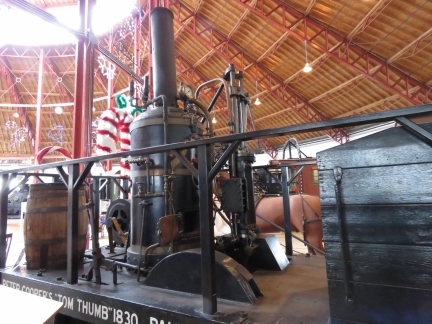 |
Tom Thumb
Position: -76 37.96, 39 17.12
B&O used horse to pull its freight and passenger trains until 1830 when Peter Cooper introduced the “Tom Thumb”, considered the first successful American steam locomotive. The small coal-burning steam locomotive suited the B&O’s planned right of way and track, had an upright boiler, and could travel at a then-impressive 10-14 mph.
|
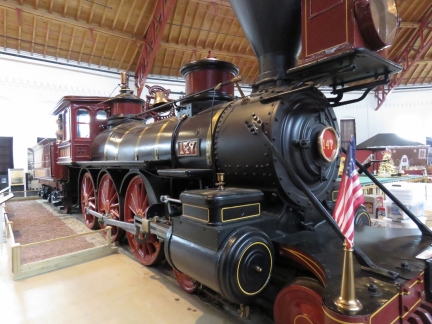 |
B&O 147
Position: -76 37.95, 39 17.11
The B&O No. 147, built by B&O Railroad in 1863. This is a ten-wheeler design that B&O first introduced a decade earlier to handle Virginia’s steep mountainous grades.
|
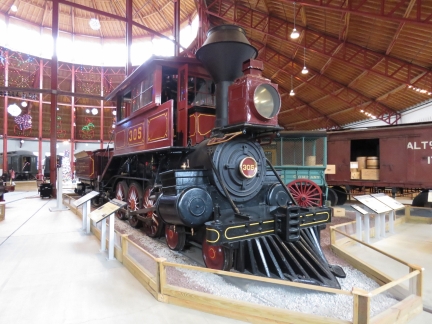 |
B&O 305
Position: -76 37.95, 39 17.12
The B&O 305 was built in 1869 as part of the “Camel” series of locomotives that were the first produced in large quantities. The name “Camel” refers to the locomotives’ unique shape with a large firebox behind the engine’s mainframe and the engineer’s cab above the boiler. In more typical designs, the engineer and the fireman are together in a cab behind the boiler and ahead of the coal and water storage. With the “Camel” design, the engineer is above the boiler in a separate space from the fireman who is keeping the boiler stoked. The design, although productive from a locomotive perspective, was dangerous for the engineer who would not likely survive a derailment and impractical for the separated crew who were unable to communicate, and was eventually outlawed by the Interstate Commerce Commission.
|
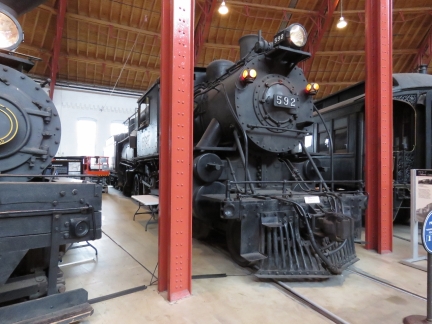 |
CNJ No. 592
Position: -76 37.96, 39 17.13
The CNJ (Central Railroad of New Jersey) No. 592 “Atlantic Camelback” was built in 1901. The design incorporated a larger firebox to accommodate the burning of waste anthracite coal, forcing the engineer’s cab to the side of the boiler. Like the earlier B&O Camels, these were dangerous and impractical for the crew and also were outlawed.
|
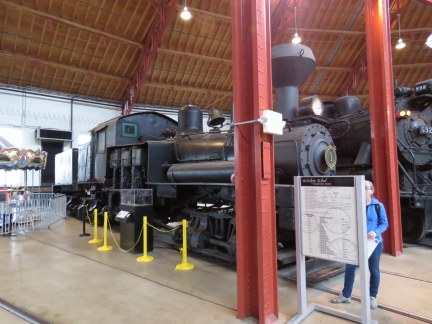 |
Shay Locomotive
Position: -76 37.96, 39 17.13
We’re familiar with Shay locomotives because they were used extensively in the early British Columbia logging industry. Until the introduction of the Shay in 1880, lumber companies used mule and oxen teams to transport heavy logs to the mill. The Shay was lighter than the locomotives of the time and featured a geared truck and boiler mounted on a flat car that could pivot, allowing it to handle the steep grades and curved terrain of logging country. The locomotive pictured has three side-mount cylinders, which powered a long crankshaft fitted with beveled gears. The Shay locomotive was an immediate success—around 2,700 were built in over 65 years.
|
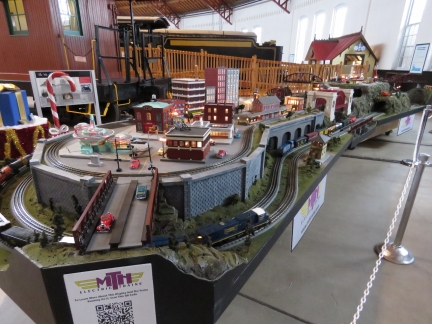 |
Model Railroad
Position: -76 37.86, 39 17.14
The B&O Railway Museum has several large model railroads with incredible detail.
|
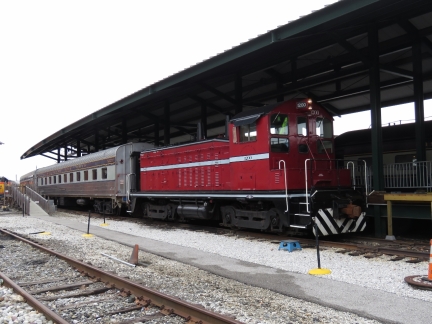 |
Mile One Express
Position: -76 37.97, 39 17.07
We booked a seat on the “Mile One Express”, a 20-minute train ride over the first commercial mile of railroad track laid in America.
|
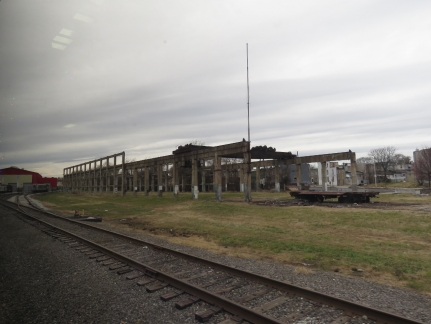 |
Locomotive Construction
Position: -76 38.52, 39 16.86
The remains of B&O’s locomotive construction building along the “Mile One Express”. The red-and-tan building on the left is where locomotives today are restored.
|
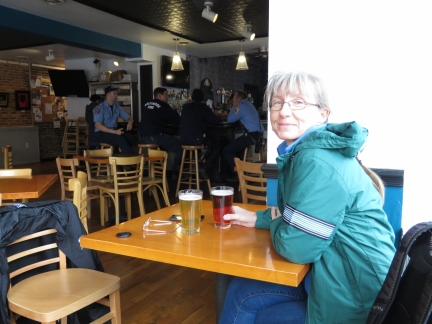 |
Zella’s Pizzeria
Position: -76 38.20, 39 17.24
We zipped the bikes over to Zella’s Pizzeria for an excellent pizza lunch after our train ride. In the background is a local fire department crew.
|
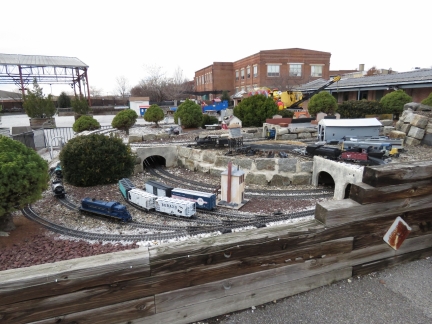 |
G Scale Model
Position: -76 38.00, 39 17.12
The museum has a large G scale model railway outside of the roundhouse building. G scale is a durable design suitable for outdoor use.
|
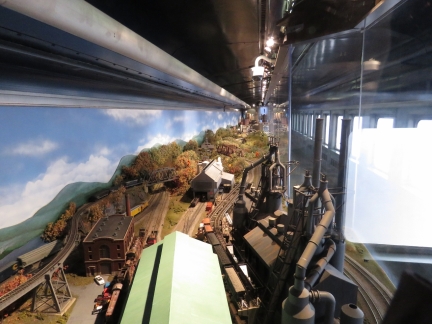 |
HO Scale Model
Position: -76 37.94, 39 17.14
This huge HO Scale Model extends the entire length of a train car. The layout represents the route from Baltimore to the Ohio River depicts the topographical challenges faced by railroads builders. Besides entertainment is used a a teaching tool to discuss topics related to railroading such as geography and the importance of signalling.
|
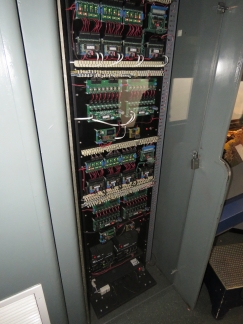 |
Control Panel
Position: -76 37.94, 39 17.14
The control panel for the HO scale model stands in a full-sized rack the height of the train car.
|
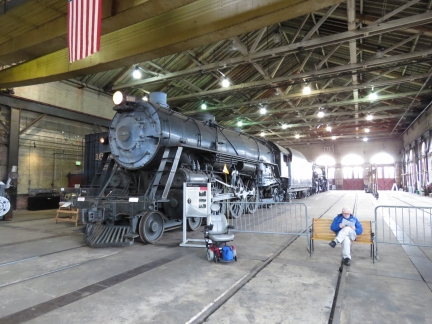 |
Washington
Position: -76 37.96, 39 17.09
The B&O built the “President Washington” in 1927, the first of 20 massive class P-7 Pacific-type locomotives. These were the flagships of the railway, known as the “President Class” because they were named after US Presidents.
|
 |
Washington cab
Position: -76 37.97, 39 17.07
Jennifer looking out from the cab of the “President Washington”.
|
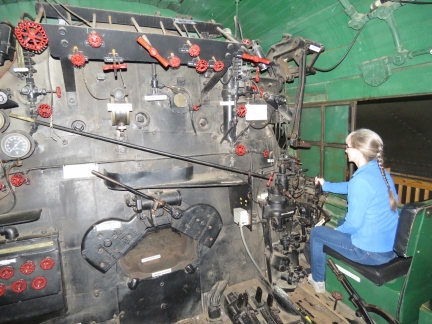 |
Allegheny
Position: -76 38.00, 39 17.06
At the controls of Chesapeake & Ohio’s No. 1604 Allegheny. These locomotives were designed in the 1940s to handle the tough Allegheny Mountain grades more efficiently than contemporary designs. The new locomotive had a 109-inch wide boiler and a fire box that was so large it required a six-wheel trailing truck to support it.
|
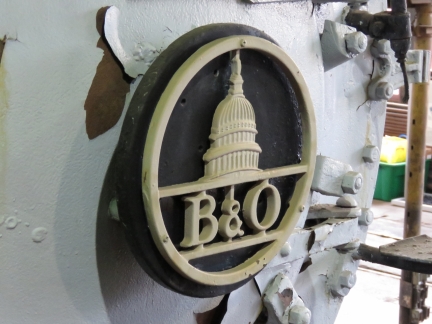 |
B&O Emblem
Position: -76 37.98, 39 17.07
The B&O emblem on the front of the B&O No. 4500. During World War I, the federal government took control of the nation’s railroads and formed the United States Railroad Administration (USRA) to efficiently mobilize troops and supplies. The B&O No. 4500 was the first USRA locomotive produced under federal management and was constructed in just 20 days by Baldwin Locomotive Works, It was equipped with the latest technology of its time, including a superheater and stoker.
|
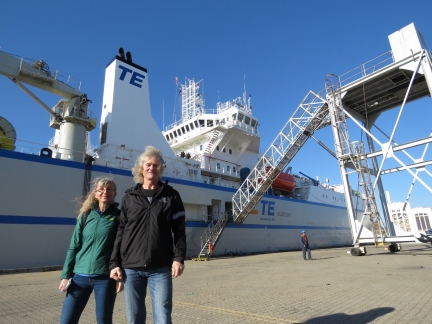 |
CS Responder
Position: -76 36.20, 39 15.99
Today we visited TE Connectivity, a $12B global techonology company that specializes in connectors, sensors and electronic components and has a major business laying and maintaining undersea cable. TE has a base in Baltimore where one of their cable layers, CS Responder, was in port. The visit included an overview of the TE Connectivity cable-laying business and their solutions, demonstrations on how undersea cables are made, and best of all, a tour of their cable layer CS Responder. Read more …
|
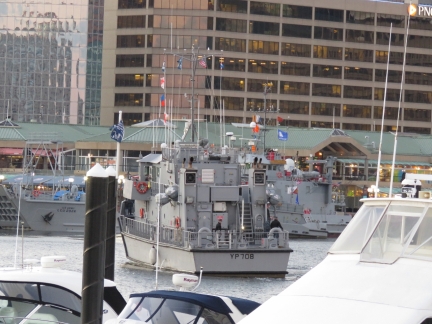 |
Navy vs Army
Position: -76 36.51, 39 16.94
Navy Yard Patrol Craft 708 arriving into Baltimore inner harbor as part of the festivities for the big Navy vs Army college football game that will take place tomorrow at M&T Bank Stadium where we watched the Ravens game. This was one of at least four Navy ships that arrived today.
|
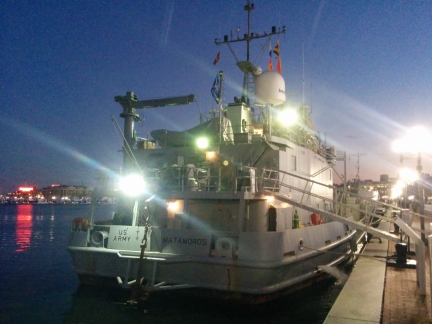 |
USAV Matamoris
Position: -76 36.73, 39 17.06
The Army also had a couple of vessels in port for the big game, including the USAV Matamoris, a 174-ft landing craft.
|
 |
Click the travel log icon on the left to see these locations on a map, with the complete log of our cruise.
On the map page, clicking on a camera or text icon will display a picture and/or log entry for that location, and clicking on the smaller icons along the route will display latitude, longitude and other navigation data for that location. And a live map of our current route and most recent log entries always is available at http://mvdirona.com/maps. |

Hi James, Hope you and Jennifer have a wonderful new year and safe passage ahead of you. Thanks for sharing all your adventures with us. Best regards, Stewart
Thanks and Happy New Year to you as well Stewart.